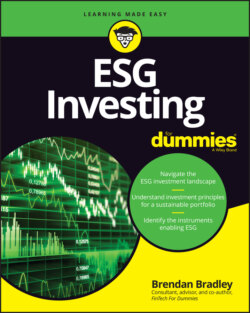Читать книгу ESG Investing For Dummies - Brendan Bradley - Страница 35
Go green: The changing global environment
ОглавлениеMany investors consider that the global environmental future is the highest-priority ESG issue facing investors. Problems such as greenhouse gas–induced climate change, pollution, deforestation, biodiversity, and water pollution have serious and sometimes unclear implications. To understand global environmental change in the last 50 years or more, you need to focus on the connections between environmental systems, predominantly the atmosphere, biosphere, geosphere, and hydrosphere, and human systems, which include cultural, economic, political, and social systems. These systems interact where human actions create environmental change, directly altering aspects of the environment, and where environmental changes directly impact human values.
As you may know, the major contributors to the buildup of greenhouse gases include the burning of fossil fuels for heating and energy creation and the use of chlorofluorocarbons (CFCs) as aerosols and coolants. Air pollutants include carbon monoxide, lead, sulfur dioxide, and nitrogen dioxide, which are all by-products of industrial and energy-creation processes. Moreover, stratospheric holes in the ozone layer are considered to be a direct result of the buildup of CFCs in the upper atmosphere.
Therefore, to tackle climate change and decarbonize the global economy, there’s a need to generate political action, social change, and financial support. The COVID-19 pandemic has shown that, faced with an imminent humanitarian crisis, a huge amount of political action can be implemented very quickly. Also, societies have changed their behaviors in a matter of weeks, and there’s been a great deal of financial backing to support these measures. The scale and pace of change for environmental concerns hasn’t been anywhere near comparable, but the pandemic may be a catalyst for further environmental action, with a greater emphasis on climate change after the crisis.
It’s now the final decade to address the UN’s Sustainable Development Goals (SDGs), which set targets in 2015 for the world to become safer and more sustainable by 2030, based on the principle of “leaving no one behind.” To realize these impressive goals, policymakers and businesses must share the responsibility to mitigate and adapt to the risks of the climate emergency. This is further supported by the business case for environmental change as companies that manage sustainability risks and opportunities tend to have stronger cash flows, lower borrowing costs, and higher valuations over time. Visit www.un.org/development/desa/disabilities/envision2030.html for details on the SDGs, and see Chapter 3 for more about the environmental aspect of ESG investing.
